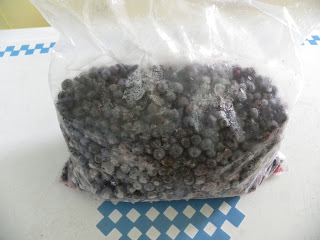“Use what talents you possess; the woods would be very silent if no birds sang there except those that sang best.” Henry van Dyke
Tuesday, September 18, 2012
Local Food and Winter Blahs
There are other colours for winter foods besides brown. If you are trying to go local or organic, this winter preparation will help to make your cooking more interesting. All it takes is about 2 hours on a weekend afternoon, 3 veggies and one box of snack sized zip lock baggies, one cookie sheet, a broiler or a bbq. If you want to go extreme, add in one fruit and one very large zip lock baggy.
Here's how:
Clean out your freezer of junk and knock off the ice build up.
Buy 1 box of snack sized baggies. Find one or two large sized baggy or 3 of the plastic bags that veggies go into at the grocery store.
Buy (from the Farmer's Market at Seaport on Saturdays, or the Farmer's Market at the VG Hospital on Fridays):
one bunch of celery
10 red peppers or a selection of different coloured peppers, not green (because green makes you burp).
10 small eggplants
4 pints of blueberries
Wash all of the above and do the following:
Celery - make sure there isn't any dirt in the lower regions or the leaves. Cut the root off. Cut the entire plant up into 3-4 inch bits. Yes, the leaves also. Toss it around a bit so there is an even distribution of leaves and stems. Stuff into baggies, squeeze out air, place on a cookie sheet or a shallow cardboard box. Wait.
Red peppers - core out the seeds. Cutting into strips is optional. Toss with olive oil or any other cooking oil, but sesame oil might be weird. Roast on a BBQ or under a broiler until pepper has lost its shape. This usually means the skin will burn. Allow to cool. Using a rounded spoon, scrape off the burnt skin. Stuff into baggies, remove excess air and place onto cookie sheet and Wait.
Eggplants - cut into quarters. Toss with olive oil or another oil. Sesame oil might be interesting for these. Roast on the BBQ or under a broiler with the red peppers. They are done when they are completely soft. They may take a bit longer than the peppers. Using a sharp knife, peel off the burnt skin, if you don't like it, otherwise, leave it on. Once cool, stuff into baggies, remove excess air and move onto step 2.
Blueberries - wash all the blueberries, remove any stems or bugs, place onto a large tea towel and sort of gather up the tea towel into a bowl shape. Shake the bowl shaped towel so the berries dry. Place all the berries into the large baggy or the several thinner bags. Place at the front of your freezer so you see it every time you open the door.
Step 2 for veggies:
All the baggies except the blueberries have been place on the same cookie sheet, No? If not, then do so. Place the cookie sheet in a level position in the freezer. Let freeze for 10 hours.
Step 3 for veggies:
If you are an organized person, remove the frozen baggies from the cookie sheet, return cookie sheet to its home. Place the 3 frozen veggies into the door of the freezer. Make a sign to remind you they are in the freezer. If not, just make the sign and tell someone where the cookie sheet is this winter.
How to use your fruit and veggies when the winter is looking pretty bleak for local food stuffs.
Celery - use in making homemade soups, chop into chili or spaghetti or bean soups, add to casseroles, and you have a few spots of green in another wise dull looking dish.
Red Peppers - add to anything that is looking forlorn. Add to pizzas, foccaio, hummus, bean soup or salad, eggs, chicken sauces, fish sauces. Whatever, it adds a nice red to everything.
Eggplants - really, these are brown, but they are a good protein source and can be added as is, or pureed to pizzas, eggs, pasta sauces, into meatloaf. They just extend the flavours of winter a little bit. Some people think they are tasteless, but I think they add a dark, roasted flavour to food.
Blueberries - chip off a 1/4 to 1/2 cup at a time and add them to muffins, plain cakes, coffee cakes, oatmeal cookies, oatmeal, pancakes, french toast, yogurt, applesauce, smoothies, drinks, martinis, and you have a nice blue juice. No long distance fruit for you!
Subscribe to:
Post Comments (Atom)



No comments:
Post a Comment